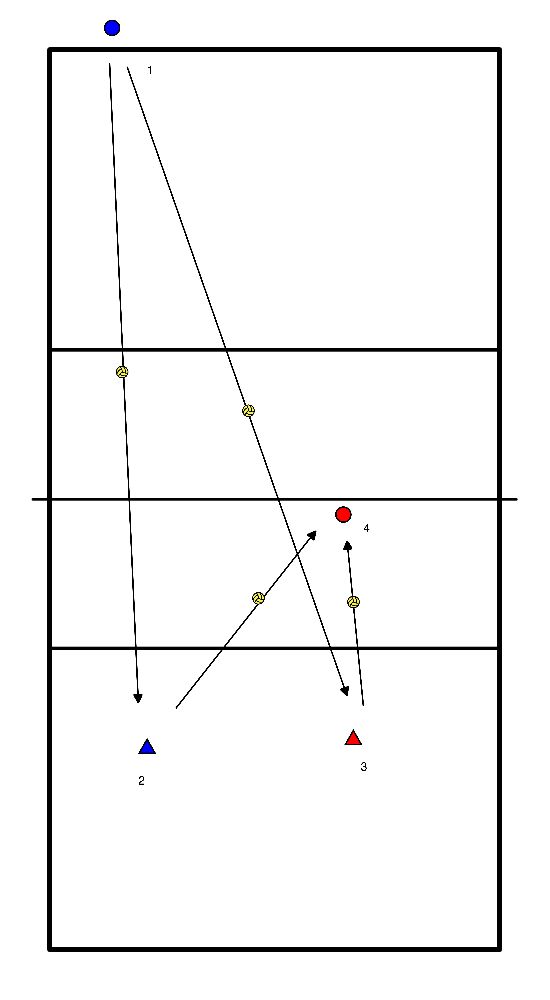Volleyball exercises for u15
- Organisation:
- Trainer with ball pit on field B
- Field A: player on 2/3.
- Player on 3 and 4, both in the pass.
- Other players behind the backline.
- Execution:
- Trainer serves OH and from the pass is attacked.
- 1st choice is p3 otherwise to p4.
- Ball is attacked.
- Each player has a sit up ball - 9 different core-stability exercises
- The Grasshopper:
- To get the most benefit from this exercise, make sure your body is in a straight line from head to toe, your hips are square (parallel to the ground) and your abs are tucked in and braced.
- Your hips should not sink at all during the movement, especially when you return to full length from the knees inwards.
- Another important point is to make sure your shoulders fall over your hands at all times, so your body doesn't rock back and forth, largely losing the benefit of this stability ball exercise.
- If you have sensitive wrists, use a pair of dumbbells as a base for your hands, this will keep your wrists in a more neutral position and reduce their strain.
- Push ups:
- Keep your hands on the side of the ball so your wrists are more neutral and very slowly lower to the ball to make this a good challenge.
- Just before your torso hits the ball, explosively (yet controlled) push back up.
- Straight Leg Deadbug:
- To get the most out of this exercise, make sure your arms and legs are always pressed into the ball.
- Even if you extend one arm and leg to just above the ground, the leg and arm still holding the ball should be pressed into the ball.
- Back leg position:
- Place your arms to the side or under the lower back if more support is needed there.
- Start with your legs perpendicular to the ground and on either side of the ball.
- Then rotate your legs so that your right leg is in front of the ball (facing you), while your left leg is on the other side (facing away from you).
- Pause at the end of each turn and then turn again so that the legs are reversed.
- Hamstring Roll-Ins:
- The key is to keep your hips high the entire time, so that your body is in a straight diagonal line from your feet to your head.
- Dig your heels into the ball as you drag it back to your buttocks.
- Squeeze your hamstrings and return SLOWLY to your legs fully extended (remember to keep your hips up).
- Ball Sensitive Twists:
- Start with your hands on the ground, shoulders above your hands, abs braced, body in a straight line and feet on either side of the ball, activating your groins to keep your legs from slipping.
- This alone is a huge benefit.
- Next, slowly rotate your hips to the right so that your foot touches the ground.
- Use your obliques to pull your hips back square and then to the other side.
- Remember to keep your hips at shoulder height the entire time.
- Ball Planks:
- Here I want you to dig your forearms and especially your wrists into the ball.
- This alone will increase your core activation 10-fold.
- Tighten and brace your abs, keep your hips up, and glutes and quads contracted.
- Next, simply move the ball around in a small circular motion, moving only your arms.
- Your whole body should stay still like cemented concrete.
- Lateral Scratch Runs:
- The ball should be under your head and shoulders and feel like a pillow, while your arms are stretched out to the side and fully locked/contracted.
- As with all of these stability ball exercises, the key with this one is to make sure your hips are up and your body is in a straight line from your knees to your shoulders.
- Push-Ups:
- This is a pretty easy move as you go down and pull your knees towards your wrists.
- This, of course, also causes the ball to roll inward.
- But the real test begins when you push yourself out of this "tucked in" position. Try it and convince yourself.
- 3 players in the field and SV4.
- Trainer plays different ball in the field, 3 count must handle the balls and make sure SV4 can handle the ball.
- SV4 plays the ball to the trainer every time.
- After 10 balls, change 3 players.
- Short/long.
- Trainer throws ball to position A1.
- Player 1 passes the short ball and runs to the middle.
- Trainer throws ball to position B1.
- Player 2 tries to pass ball back from A2, and gets ready for ball on A1.
- Then trainer switches to the other side.
- Trainer throws ball to A2.
- Player 2 passes the short ball and runs to the middle.
- Coach throws ball on to B2.
- Player 1 tries to pass ball on B2, and stands ready for ball on A2.
- Other players?
- Three get balls.
- 3 encourage.
- After 10 balls, change groups.
- 2 trainers available?
- 1 trainer makes sure the player in the middle does not cheat by starting too fast. (and keep him/her in the middle).
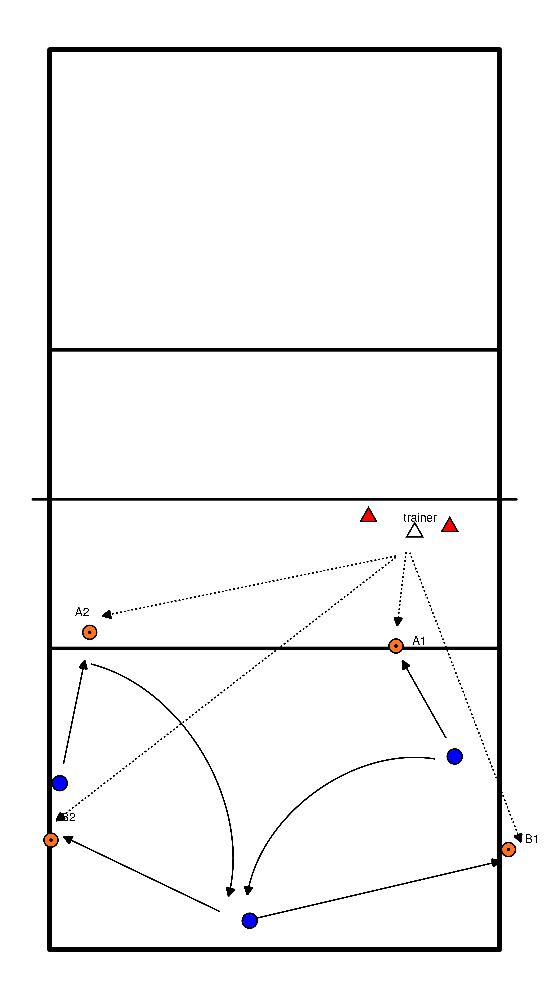
- Trainer pours ball to position 1.
- Player from starting position (circle) runs passes back to trainer/catcher, and runs to pawn at 3 meter line.
- Other players also get ball and join behind player 1.
- Then trainer throws ball at position 2, passes and walks to other pawn 3 meter line.
- Other players also get a ball and join behind player 1.
- Then trainer throws ball on position 3, passes and walks to other pawn at serve. (via pawn 3 meter line)
- Other players also get a ball and join behind player 1.
- Then trainer throws ball on position 4, passes and continues to other pawn at starting position. (circle)
- Other players also get a ball and close behind player 1.
- Goal:
- Wherever the ball is, it always goes towards the goal. (sv simulated by catcher/trainer)
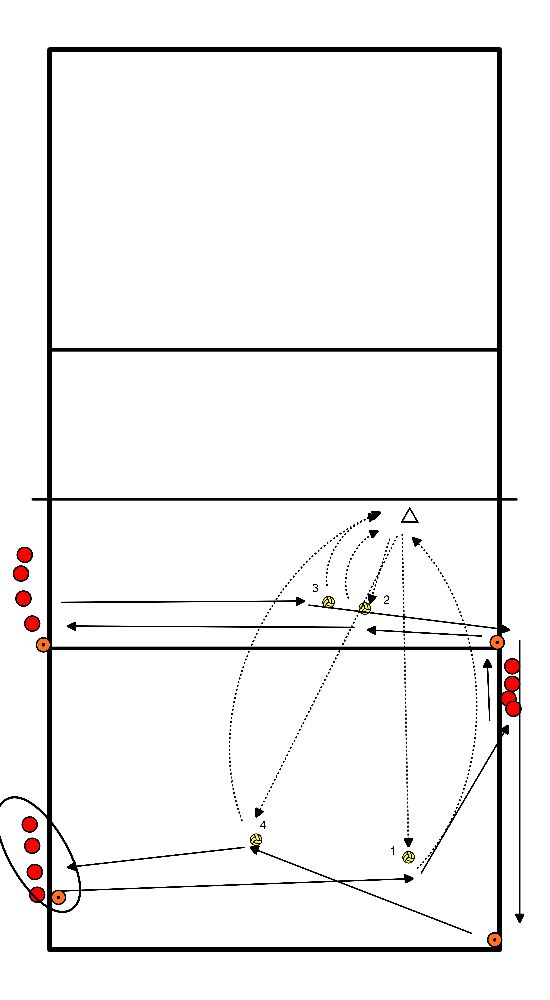
- The group divides into pairs.
- In each field stands a pair.
- The trainer throws in a ball.
- The team that scores a point runs to the posts and gets the next ball first.
- The team that made a mistake goes out and is exchanged for another pair.
- (The game can also be played in threes if this is more convenient).
- The trainer stands in the middle near the net.
- One player stands in the field.
- The trainer throws the balls all over the field.
- The player is only done when he/she has touched/played three balls in a row.
- When the player misses the second or third ball the trainer starts the count again.
- Organisation:
- Trainer with ball carrier on P6.
- 1 player starts at P3.
- Other players stand around the field and take care of ball safety and returning the ball to trainer.
- Execution:
- Trainer throws the balls randomly into the field in a calm tempo.
- Player must try to play the ball, but must touch it as little as possible.
- After 10 times success change.
- You have 2 teams one is on one side of the field and the other on the other side.
- There is a ball played in the field the ball may fall on the ground 0/1 time the ball is passed by the teams to the other side of the field.
- If the ball either bounces 1/2 time, goes out or wrong technique a team has a point.
- Ball route:
- Player 1 serves to player 3.
- 3 passes the ball on 2/3 to player 4.
- Player 4 gives set-up.
- Player 3 comes for the attack.
- He hits straight ahead or diagonally.
- Agree on beforehand.
- Server (player 1) defends this ball.
- Walking route:
- After player 1 serves, player 2 serves.
- Player 3 and 4 exchange tasks.
- When one side has served twice (player 1 and 2).
- Player 3 and 4 start serving.
- Player 1 and 2 attack and defend.
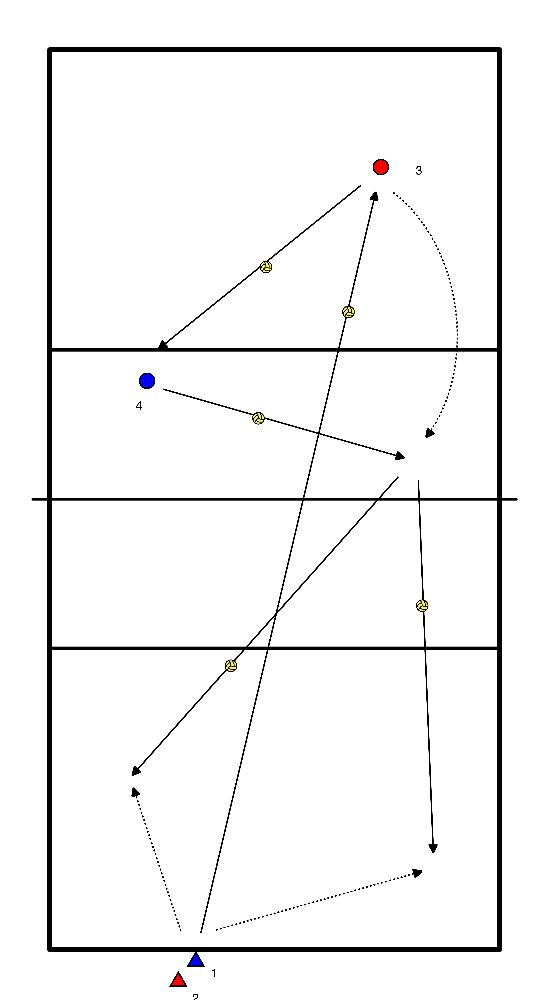
- 2 on 2, each side passes, gives a setup and then an attack behind the 3 meter line.
- The game is played on the whole field.
- The ball is introduced through an overhand service from the field (the ball must return to the field quickly, so serve directed at a defender where the ball lands).
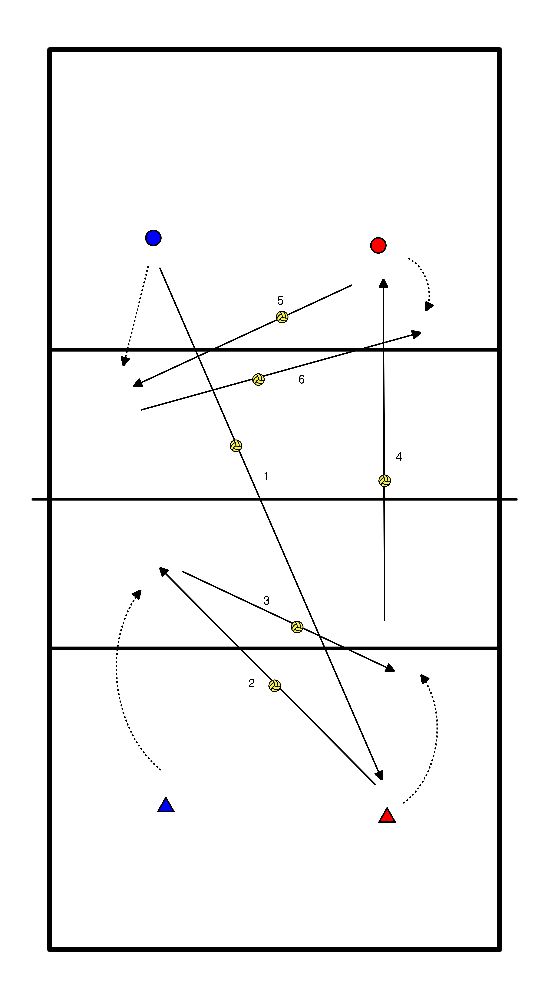
- Serve target:
- Player 1 serves 3 good balls to the 2 passers (player 2 and player 3).
- 2 and 3 pass the ball to player 4.
- The ball that is caught is rolled to the server.
- When there have been 3 passes, the system is continued:
- Player 1 starts passing.
- Player 2 continues to pass.
- Player 3 is going to catch.
- Player 4 is going to serve.
